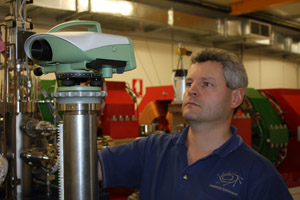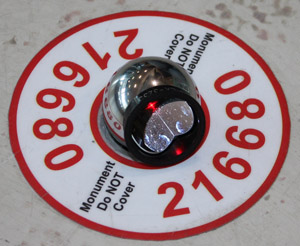 When the synchrotron was built, its concrete floors were carefully poured to ensure a flat, stable surface. This is critical to the production and alignment of the synchrotron x-ray and infrared light beams that are generated in the storage ring and must then travel down the length of the beamlines to reach the specialised equipment used for research experiments.
When the synchrotron was built, its concrete floors were carefully poured to ensure a flat, stable surface. This is critical to the production and alignment of the synchrotron x-ray and infrared light beams that are generated in the storage ring and must then travel down the length of the beamlines to reach the specialised equipment used for research experiments.
Under the supervision of senior engineer Jonathan McKinlay, synchrotron technicians Jason Wirthensohn, Alan Easdon, Trent Smith, Craig Hodgson, Robert Grubb and Robert Rostan have just finished painstakingly surveying 324 network points on the technical floor that houses the beamlines and in the heart of the synchrotron building: the storage ring, booster ring and linear accelerator.
 The network re-survey is conducted every 18-24 months to find out by how much the synchrotron floor has shifted and whether this might affect the position of any equipment inside the synchrotron light source – in particular the alignment of the synchrotron beams.
The network re-survey is conducted every 18-24 months to find out by how much the synchrotron floor has shifted and whether this might affect the position of any equipment inside the synchrotron light source – in particular the alignment of the synchrotron beams.
The synchrotron’s accelerator physicists can adjust the controls on the electron beam to accommodate gradual changes of the order of several millimetres in the position of the powerful magnets that control the movement of the electron beam inside the storage and booster rings. However, ensuring that the equipment inside the synchrotron light source is as close to possible to its ideal positioning helps to achieve optimum performance. The network survey also helps to ensure that new equipment can be installed with the required accuracy.
The survey process involves placing a spherical metal ball at each network point, and using a laser tracker to very accurately measure the precise position of a mirror inside the sphere. Heights are measured using a yardstick with a unique barcode at every point along its length. The survey can detect changes of the order of just 30 micrometres, or one-quarter the thickness of a standard piece of copy paper, in the position of a seven-tonne storage-ring magnet. The information is recorded in a database of coordinates for every single network point.
For the record, the 0.6 mm shrinkage in storage ring diameter noted between 2008 and 2010 was accommodated by a realignment of the storage ring in which all the magnets and girders were moved back to their nominal positions, or as close to this as practically possible.
Top LHS photo: Alan Easdon prepares to measure another set of network points at the Australian Synchrotron
RHS photo: Engineers recently re-measured the precise position of 324 network points like this one
